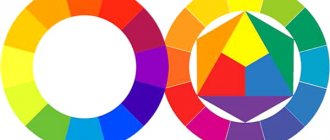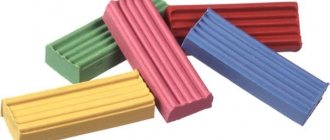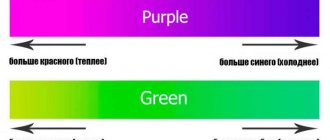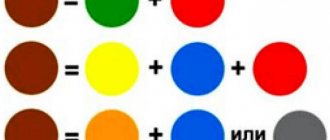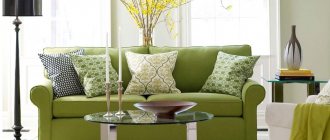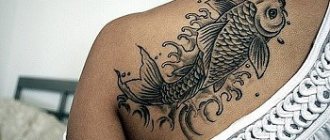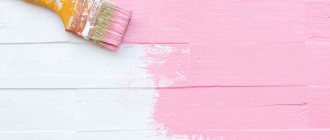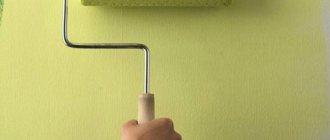» How to get color » How to get green by mixing paints
How to get green color and its shades by mixing paints? Classic green is the result of mixing blue and yellow. Other colors help create shades of green. Photo.
The green palette is obtained by mixing yellow and blue. A wide range of shades of green depends on the proportions of mixing primary colors, as well as the introduction of additional darkening or lightening tones: white and black. In addition, olive and khaki shades are a product of mixing yellow, blue, black and brown.
The intensity of the color depends on the quality of the dyes, as well as on the number of mixed colors: the more shades involved in the formation of the tone, the duller the resulting color. Showing mixing using my own paints as an example, I explain the essence of creating a shade. Your dyes may give a different undertone, since they initially differed in the undertone of the collier, you should adjust using proportions or other primary colors (white, green, blue, yellow, red and black).
How to get a medium green color by mixing paints
To get a medium green, you will need yellow and blue, usually in a ratio of 1 to 1 or 1 to 1.5 towards yellow. Blue can be replaced with cyan, if available, then the shade of green will be lighter.
The brightness of the resulting color will depend on the purity (saturation) of the basic tones: yellow and blue. The more intense they are, the brighter the green color will be, however, it will always be duller than the main dyes. Actually, that’s why paint sets are sold that already include this shade.
If yellow and blue are primary colors, and green is secondary, then all subsequent shades: dark (with the addition of black or brown) and light (with the addition of white) will be tertiary, that is, even duller than the green color itself.
Characteristics of yellow color
Yellow is one of the brightest colors in the spectrum. It refers to basic shades that cannot be created from other components. Its tones evoke the greatest number of associations. This is due to the fact that the eye is able to distinguish the maximum number of tones in this part of the spectral circle.
It is believed that yellowish shades tone up, improve mood, sociability and brain function.
How to get yellow-green by mixing paints
Yellow-green color can be obtained by mixing green and yellow. Depending on the proportion, you can get light and medium shades of yellow-green. You can skip the step of creating a medium green and just add less blue dye to the yellow, which will give you the same result with less dye.
Yellow blue green mix what color will be if you mix red and yellow
What color will you get if you mix yellow and green?
If you mix green and yellow colors in equal proportions, you get a color that we usually call light green. Depending on how light or dark the original colors are, the result will vary from light green to olive.
But if you mix green and yellow in clothes, nothing good will come out) This combination can only be worn by representatives of the winter color type, and even then it’s not worth it)
If you take yellow as a base and add green paint, you will get a light green color or shade, since everything will depend on the amount of paint that you want to add to the base color.
If you want to continue the experiment, you can add a little white paint to the light green one and get a lighter and less saturated color.
Yellow will give green the opportunity to sparkle with a variety of shades. There will be less yellow - the green will only become slightly brighter, more golden, but if there is more, then the green color can be brought to light green. How to change the color of pink paint, what color should I mix to darken it?
In general, decide what color you want to get as a result - more yellow or more green, and depending on this, select the desired proportion of mixed colors.
Light green color can be used to paint fresh grass and leaves. It will give the picture a juicy spring character.
Mixing green and yellow dyes will also be useful for cooks: it is this light green color that is most often found on flower petals on cakes.
Which is better: heated floors or radiators?
Warm floorBatteries
If you mix any two paints, you can get many different shades. Moreover, depending on how much of one paint is mixed with another, the resulting color approaches either one or another color.
If we have two colors: yellow and green, then mixing the colors in equal proportions will give a light green color.
If you gradually add green paint to yellow paint, you can see how the resulting paint changes its color, getting closer to green with each new drop.
Knowing how to get a particular color correctly, you can create completely unexpected shades. And if you add another color , you can get, for example, the following colors:
The answers to this question will be different if you do not ask the exact characteristics. The final color when mixing yellow and green depends on their initial shades and saturation. This can be clearly seen from the figure below.
If we mix light green and light yellow, we get a soft light green color.
If we mix rich green and yellow, we get a rich light green color.
If we mix dark green and dark yellow, we get olive color. It can also be intensified to dark olive.
By the way, in life the combination of yellow and green is quite acceptable, for example, in clothes these colors go well together and refresh a woman, and are also acceptable for a man, although they are used less often. The same can be said about their use in the interior of, say, a bedroom.
It will turn out to be an acidic, poisonous light green color - well, that’s just in my personal opinion!)
If you mix yellow and green, you get blue. Yellow red green mixed what color will be if you mix red and yellow? Depending on the proportions of the colors mixed, the shade of blue will change. If you add more green, you get a dark blue color.
And if there is more yellow color, it will turn out blue.
Mixing green with any other colors always results in a color close to brown or even an indeterminate color.
But adding green to yellow dates olive color. If you add just a little yellow, the green color will become more saturated and dark.
By mixing yellow and green colors, we get a bright light green color.
But in order to actually get a bright light green color, the proportions when mixing paints must be the same 1:1.
By adding a little more of one color and a little less of another color, you can get different colors from brown to deep blue and from blue to light blue.
When mixing green and yellow colors, a light green color of varying shades will come out depending on the proportions of these colors. Up to olive color. In general, to put it simply, it will just be a light green color.
It depends in what proportions you mix yellow and green. If the proportions are the same 1:1, then you will get a light green color. Depending on the increase in any color, the shade will change.
For example, more yellow, the color will become light green and vice versa.
Additional Information:
All colors that exist in nature are called chromatic. Yellow blue green mixed what color will it be if you mix red and yellow? This is all the variety of colors and their shades. In nature, three colors are not found in their pure form - white, black and gray.
They are called achromatic. By adding achromatic colors to others we get different shades.
This table will help you understand that the question of how to get yellow is in itself incorrect. It cannot be achieved by combining other components, since yellow belongs to three basic tones. Therefore, when the need for yellow arises, they purchase a ready-made dye or extract the pigment from natural products, which is not entirely advisable.
Red and green combined give a dark brown color. But its shade and intensity depend on the chosen proportions. The main role in this combination belongs to the color green.
The darker it is and the greater the proportion used, the more intense the brown color, even black.
How to treat the surface → Room decoration → How to choose the right paint → Surface treatment technologies → Leveling and finishing the walls → Selecting and applying a primer → Removal from the surface → Stretch ceilings and technologies → Reviews and testimonials
How to get blue-green (emerald) by mixing paints
Blue-green, emerald, malachite shades are cool tones of green with a predominance of blue. You can get them by adding blue to green, or by mixing yellow and blue and increasing the last ingredient, depending on how dark and blue-green the paint you want to get.
Shade table
You can create shades by adding different shades. Examples are given in the table:
| Resulting Tone | Paints used |
| Beige | Brown + white |
| Ivory | Brown + white + yellow, white + red |
| Eggshell color | White + yellow + a small amount of brown |
| Off white | White + brown + black |
How to get dark green by mixing paints
By mixing the primary colors that form green, we get a medium or slightly dark tone if there is enough blue in it. But sometimes you need a deep, almost black green that will depict forest or grass shadows. To do this, black is added to the resulting main shade. If we add black to mid-green, we get a warm, dark color scheme. By increasing the amount of black you can achieve a very dark color, barely distinguishable from black.
If you add black to blue-green, you get a dark, cold range that goes into black-green.
How to get olive and khaki colors by mixing paints
A huge layer of complex olive shades can be obtained in several ways. The first way is to mix medium green and brown. In this case, the tones will turn out muted, dusty with a marshy undertone. This is the sum of several colors (yellow, blue, red), so all shades will have a gray, dull tint.
The second way is to mix yellow with black. The resulting paint will have a golden tint; it will be brighter, since it is the sum of the primary shades.
Features of obtaining shades of white
In the artistic and design sphere, there are certain shades of white, obtained by adding other colors: beige, gray, yellow and others. Let's look at the most common of them.
Alabaster
It looks like alabaster with a matte surface and a touch of yellow. To obtain it, you need to mix white with yellow or lemon paint.
Amyanthus
Reminiscent of the color of amianth (a type of asbestos). It is distinguished by its whitish, dirty tone.
Snow-white
It is a bright color, a special type of standard white. Other names: immaculate or dazzling white.
Pearl
The tone is with mother-of-pearl, reminiscent of natural pearls.
Marengo
Black tone with a gray tint or white with black splashes.
Lactic
It is the color of milk, with a bluish tint. A milky tint also refers to a beige or yellowish tone.
Platinum
With a grayish tint, smoky tone.
How to get grey-green by mixing paints
Gray-greens are most often considered cool shades of green, so we will make it from an already mixed blue-green color. That is, as a secondary color, we mix cool green with complex, secondary brown and get a dusty gray-green tone. This will provide minimal shading compared to adding black or gray.
General information about white color
Refers to achromatic, that is, opposite, like gray and black tones. It is impossible to obtain it by mixing paints, since the material reflects spectral waves. Due to the peculiarity of the human visual organs, it can be obtained by mixing the main spectral colors used in film projectors and computer programs.
The color is considered basic; it has an electromagnetic radiation spectrum, where the wavelengths are evenly distributed in the visible zone. From the physics side, it is the reflection of light rays hitting parts and objects. Provided that the surface is not perfect, otherwise the rays will be reflected and begin to produce a color picture. This is the only color that is neither warm nor cold. It has the exact opposite - black tone.
How to get light green by mixing paints
Medium light green is obtained by mixing the resulting green paint with white. In this case, you need to take a significant amount of white. You can add rage to the shade by adding yellow, but then the tone will be closer to yellow-green. You can adjust the tone with a drop of blue.
As I already said: the brightness of the green tone directly depends on the brightness of the primary colors, and the brightness of the green subtones will depend on the saturation of the greens. Therefore, shades of green paint will be more attractive if they are produced from ready-made green paints, of which there are usually two in a 12-color set: bright green and emerald, which correspond to blue-green.
Visible spectrum colors
There are three primary colors, the combination of which will lead to all other shades of the palette. They are called basic and include red, blue, yellow. Black and white stand apart - these colors cannot be created by mixing gouache, watercolor, plasticine, but they actively dilute and darken different tones.
All basic tones are considered the basis of the color wheel and optical spectrum, and are included in the range of visible light radiation. If you examine the spectrum under magnification, the white pixel will be decomposed into several shades. But it would be a mistake to think that you can make white by combining such tones on the palette - this effect is only available in computer graphics.
Combining colors of the visible spectrum
If you take a color wheel divided into 7 colors (red, orange, yellow, green, blue, indigo, violet) and spin it, you can see the color white with your own eyes. Why does the human eye perceive the main shades of the rainbow this way? This happens due to the additive mixing (addition) of tones, which are again combined into a light beam (it has a whitish color). But when mixing paints, this effect cannot be achieved, because some colors will suppress others.
Whitewash cannot be obtained even with the help of a printer - you will have to pour ready-made paint into the cartridge. Attempts to combine colors always lead to the formation of intermediate tones, and sometimes completely achromatic - dirty, gray. This applies to any paints - acrylic, gouache and others.
How to Make Mint Green by Mixing Paints
Mint is a light, cool green and therefore should be mixed from blue-green and white tones, where there will be a significant amount of white. So, with small amounts of white, the tone will be jade, and strong dilution will create a menthol effect.
However, if you put aside the brightness and quality of the colors and imagine a graphical map of mixing colors to obtain shades of green, you will be able to navigate any palette.
Mixing Tools
Before you learn how to get a mint color, you need to stock up on the necessary paints and supplies.
- First, grab some clean brushes and a glass of clean water.
- Second, prepare a palette for mixing paint. This will help you achieve the exact shade before using it. You will be surprised, but even pastry chefs and painters use the palette, and not just artists.
- Thirdly, prepare several paints (watercolor, gouache, confectionery dyes).
If you do not have experience in mixing colors, it will be difficult to achieve the desired shade the first time. Don't be upset under any circumstances. It is important to understand that all paints are different in composition and concentration, so it is almost impossible to know the exact proportions. Let's learn how to get mint color in several ways.
Table for obtaining green shades by mixing it with different tones
However, if you put aside the brightness and quality of the colors and imagine a graphical map of mixing colors to obtain shades of green, you will be able to navigate any palette.
Where in the center is the main paint for mixing. The first circle is the shades to be mixed with the main paint, the second circle is what happened when mixing green paint and one adjacent tone. The third circle is the shades of the previous circle mixed with the main one, white and black.
How to get other colors and their shades: theory and practice. Click on the icon.
One comment on “How to get green by mixing paints”
- Rafaelen
August 24, 2016, 3:26 am
How to achieve a gray-beige color, in the style of concrete... does anyone have any idea how to get uneven paint coverage, streaks?
Rules for mixing colors
To obtain the desired shade, you need to follow a number of provisions that will help achieve the result. The basic rule is that you cannot mix liquid dyes and dry mixtures. They contain different components, the interaction of which will cause the coloring composition to coagulate.
Another condition is mixing paints of the same type, for example, acrylic or oil. This way you can obtain a homogeneous mixture, which is subsequently used for painting surfaces.
It is not recommended to mix paints produced by different manufacturers. It is best to take shades from the same batch. You should first mix the coloring materials in a small area to evaluate what color you will get.
